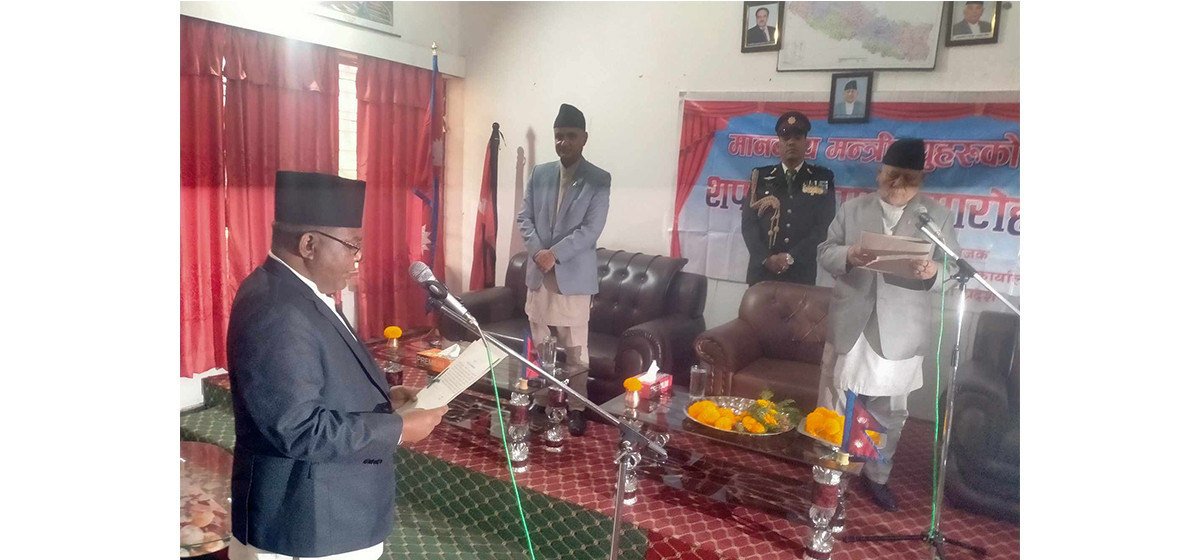
OR

Though plagiarism is considered a misdemeanor and a punishable act under the Copyright Act (2002), offenders are rarely brought to the book.
Frankly, our education system doesn’t encourage students to think critically and experiment with innovation in the classroom. Neither teachers nor students do things in the classroom that could challenge the conventional practice of teaching and learning. A student would secure a good mark if s/he can replicate book lines in the answer sheet. Our education system doesn’t encourage passion for learning rather it focuses on rote learning. Nowadays, classrooms are just a lab of rote memorization to pursue good marks. And, this is how the practice of plagiarism is taking place.
The Miriam Webster Dictionary defines plagiarism as literary theft and the stealing and presenting of another's ideas as one’s own, without crediting the source.
A couple of weeks ago, I visited one of the prestigious government colleges in Kathmandu. I went to the college library. I found that every fifth dissertation in a row completely matched, including its title and contents, with other four. On my way back home, I heard some students talking about purchasing ready-to-go dissertations for their master’s degree.
Our university is producing thousands of graduates every year but many struggle to produce a good piece of writing if asked. The graduates can be affected as their degree can be valued by the tag of cheating. So with the brand of the academic institutions on the global market, which could prevent students from getting admission in the best universities of international repute. Academic plagiarism is not limited to the students. Many bigwigs of different universities of Nepal are found to have committed plagiarism to get promotions.
Few cases
The exact number of plagiarized works submitted to the universities is still unknown as there is no mechanism to check and recheck the submitted materials. However, it is not hard to predict that plagiarism is widespread.
According to the report published by the Centre for Investigative Journalism-Nepal (CIJ-Nepal), Prof Dr Kedarnath Ghimire, the then head of the Central Department of Chemistry, Tribhuvan University (TU), was allegedly involved in plagiarism. His paper “Chemical Modification of Natural Polymers and their Applications in Best Drinking Water” was found to have copied materials from the paper published by Nepal Academy of Science and Technology (NAST).
The article “Authentic Materials and Cultural Content in EFL Classrooms” of Prof Dr Tirtha Khaniya, the then Vice-Chancellor of Tribhuvan University, appeared like a patchwork of copied and pasted ideas. Dr Khaniya had lifted almost everything from a Turkish scholar, Ferit Kilickaya’s article “Authentic Materials and Cultural Content in EFL Classrooms.”
Dr Meena Vaidya Malla, Professor at TU’s Department of Political Science, was also found to have committed plagiarism. Her research paper entitled “Nepal’s Problems of Political Culture in Transition Management” was lifted from Bishnu Raj Upreti’s paper “Management of Post Conflict Political Transition in Nepal: Challenges and Opportunities” and Devraj Dahal’s article “Nepal’s Problem of Order and Political Culture” without reference and citation.
Karna Bir Poudyal, the then dean of the faculty of management, Pokhara University, was found to have lifted the conclusion section from Rup Bahadur Khadka’s paper “The Evolution of the Nepalese Income Tax System” in his article “Inflation Impact on Salary Tax Rate Structure in Nepal.”
According to the report published by Republica few years back, Bali Medical Journal (BMJ) of Indonesia had blacklisted the research paper jointly authored by Dr Mukesh Kumar Shrewastawa, Dr C Thanpari, Dr RK Goit, Dr NK Yadav, Dr RK Mittal and Dr V Rohil. The paper entitled “Association of Thyroid Dysfunction Among Infertile Women Visiting Infertility Center of Om Hospital, Kathmandu, Nepal” had been cripplingly lifted from the Nepal Medical College Journal, authored by Dr Bhola Rijal, Dr R Shrestha and Dr Bharat Jha. Among them, five doctors are associated with Kathmandu University.
These pieces of evidence are just the tip of the iceberg. The gravity of error is beyond our imagination.
Our education system has failed to promote desirable professional behavior because incompetent people are ruling the roost and they are transmitting the kleptic psyche to our students and professionals.
Why people plagiarize?
Ferro and Martins believed that many people who plagiarize feel that plagiarism goes unpunished given that there is a high probability of not being caught or of not being punished even when they are caught. Yusof, on the other hand, is of the view that people don’t have a culture of acknowledging the work of others. Some people assume that everything in the public domain is free to be used and get published. Some people plagiarize to achieve efficiency with no time invested, while others plagiarize to get promotions. Students plagiarize to get easy grades. Absence of original ideas among the professionals and students would be another cause. Shishir Subedi in his article “Plagiarism in Nepal: Writing without Worries” writes that people want a drastic change in their writing in a short period and thus end up plagiarizing.
Though plagiarism is considered a misdemeanor and a punishable act under the Copyright Act (2002), offenders are rarely brought to the book. There are many instances where plagiarists get rewarded even after they are found guilty of plagiarizing. Western society, however, treats plagiarism as an evil, a wrongful deceptive act that undermines trust and compromises the integrity of the confirmed plagiarists. For them, it’s a matter of public shame. In the worst cases, plagiarists end up losing their careers and jobs.
Many people claimed that buying plagiarism detection softwares like Turnitin, iThenticate, Copyleaks etc and teaching the rules of paraphrasing, referencing and citations to the students and professionals to prove authorship and weeding out instances of duplication may help put an end to plagiarism. They have been proven wrong.
When you write, you are supposed to contribute toward existing knowledge thus serving as a springboard to the new researchers. Alas, our universities don’t care about research-based knowledge and innovation.
The Covid -19 pandemic has created the largest disruption of education system in our country because we are still following the traditional approach of teaching and learning. The way out of this crisis could be innovation within the education system. It will take time to change the teaching and learning practice but I am sure, that will be a step towards new thinking and innovation of ideas. This kind of practice in the education system could prevent students and professionals from being involved in the fraudulent act of forgery and piracy.
The probable solution, therefore, would be to change the internal structure of the education system. Creativity and originality of others should be treated as creativity and originality of others. For innovation, one has to be creative oneself.
You May Like This

Tertiary Education at a Crossroads in Nepal
In recent years, a growing number of students have approached me for migration certificates or recommendation letters to leave the... Read More...

400 students of Nalgad unable to go to school as flood washes way bridges
JAJARKOT, Aug 18: Flood triggered by continuous rainfall has swept away bridges in various parts of Nalgad Municipality of Jajarkot... Read More...

Open Doors Report: Nepali Students Fastest Growing Enrollment in U.S. Universities
KATHMANDU, Nov 15: According to the 2017 Open Doors Report, Nepali students studying in U.S. universities are the fastest growing... Read More...








Just In
- NC lawmaker Gurung’s suspension lifted
- Homicide accused arrested after 17 years
- Karnali: Maoist Center’s Pariyar appointed as minister without portfolio
- Illam by-election: Nepal-India border to be 'sealed' from midnight today
- Gold price rises by Rs 500 per tola
- Emir of Qatar returns home after wrapping up state visit to Nepal
- Senate passes bill forcing TikTok’s parent company to sell or face ban, sends to Biden for signature
- PM Dahal hosts luncheon in honor of Qatari Emir




_20240423174443.jpg)






Leave A Comment